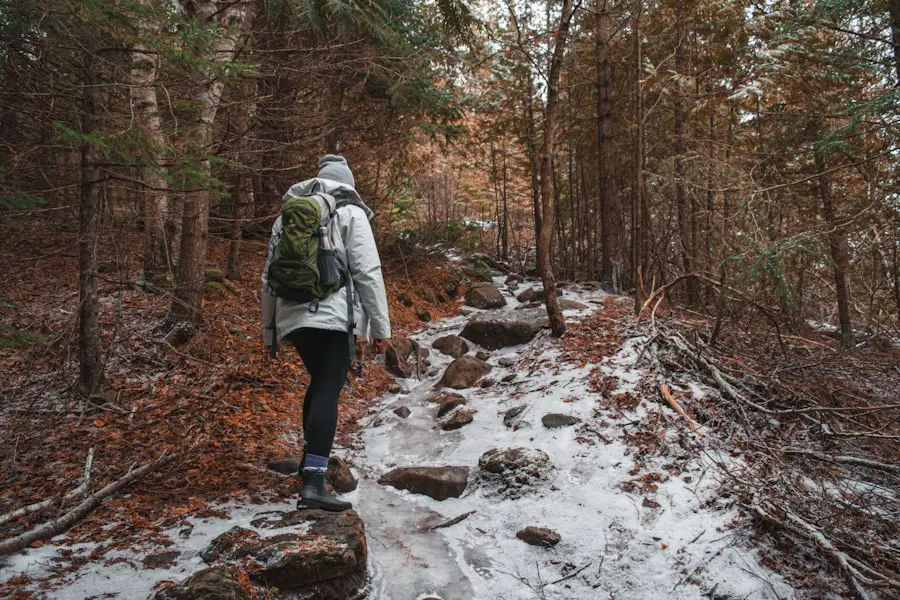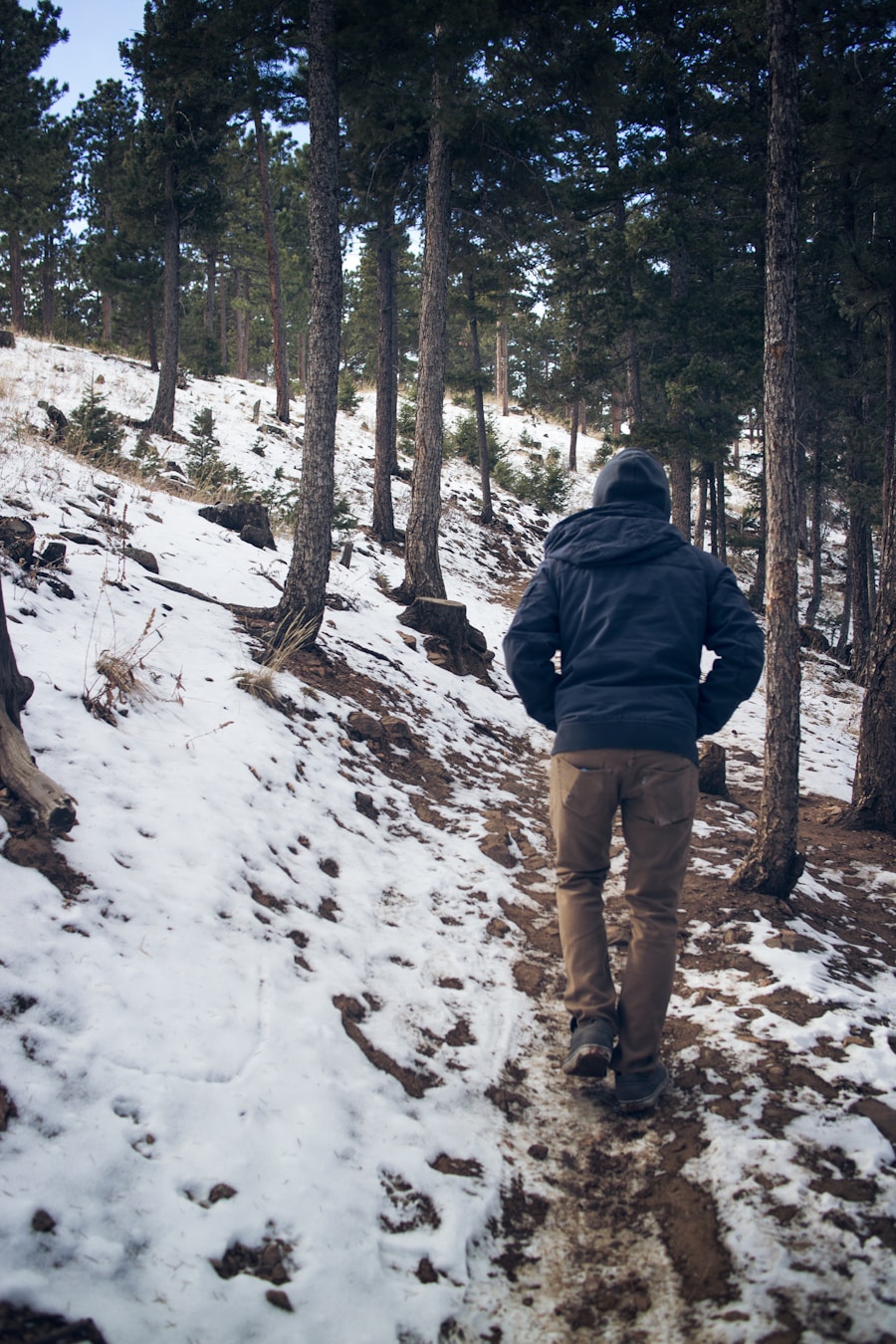When embarking on any outdoor adventure, the choice of footwear is paramount. The right pair of shoes or boots can mean the difference between a comfortable trek and a painful ordeal. Hiking boots, for instance, are designed to provide support and stability on uneven terrain.
They typically feature a high ankle design that helps prevent sprains and injuries, while their rugged soles offer traction on slippery or rocky surfaces. A well-fitted boot will also accommodate the natural movement of the foot, allowing for flexibility while maintaining support. Brands like Merrell and Salomon have gained popularity among outdoor enthusiasts for their durable materials and innovative designs that cater to various hiking conditions.
In addition to hiking boots, trail running shoes have become increasingly popular among those who prefer a lighter option. These shoes are designed for speed and agility, making them ideal for fast-paced hikes or runs on well-maintained trails. They often feature breathable mesh uppers to keep feet cool and dry, along with cushioned soles that absorb impact.
However, it’s essential to consider the terrain when choosing footwear; trail running shoes may not provide the same level of ankle support as traditional hiking boots. Ultimately, the best footwear choice will depend on the specific demands of the hike, the weather conditions, and personal comfort preferences.
Key Takeaways
- Choose lightweight and durable footwear with good ankle support for hiking and backpacking.
- Layer clothing for versatility and pack a waterproof jacket for unpredictable weather.
- Select a backpack with adjustable straps and multiple compartments for organization.
- Carry navigation tools such as a map, compass, and GPS device for safe and efficient travel.
- Pack insulation layers like a fleece jacket and thermal underwear for warmth in cold conditions.
- Bring a reliable headlamp and extra batteries for visibility during night hikes or emergencies.
- Plan nutritious meals and snacks to fuel your body during outdoor activities.
- Pack emergency supplies including a first aid kit, emergency shelter, and fire-starting tools for unexpected situations.
Clothing
Layering: The Key to Adaptability
Layering is a fundamental principle in outdoor clothing, allowing adventurers to adapt to changing weather conditions. The base layer, typically made from moisture-wicking materials like merino wool or synthetic fabrics, is designed to keep sweat away from the skin. This helps regulate body temperature and prevents chills during cooler moments. The mid-layer, often composed of fleece or down, provides insulation to retain heat. Finally, the outer layer, usually a waterproof and windproof shell, protects against rain and wind.
Activity-Specific Considerations
In addition to layering, it’s important to consider the activities planned during the outing. For example, if hiking in colder climates, thermal leggings or insulated pants can provide additional warmth without sacrificing mobility. Conversely, lightweight, breathable fabrics are essential for warmer weather to prevent overheating.
Accessories and Brands
Accessories such as hats, gloves, and neck gaiters also play a significant role in comfort; they can be easily added or removed based on temperature fluctuations. Brands like Patagonia and The North Face offer a wide range of outdoor clothing designed with functionality and durability in mind, catering to various climates and activities.
Backpack

A well-designed backpack is an essential piece of gear for any outdoor excursion, serving as the primary means of carrying supplies and equipment. When selecting a backpack, factors such as capacity, fit, and features should be carefully considered. Backpacks come in various sizes, typically measured in liters, with options ranging from daypacks for short hikes to larger backpacks suitable for multi-day trips.
A daypack usually holds between 15 to 30 liters, providing enough space for essentials like water, snacks, and a first aid kit. In contrast, larger backpacks can accommodate sleeping bags, cooking gear, and extra clothing. The fit of a backpack is equally important; an ill-fitting pack can lead to discomfort and fatigue during long hikes.
Many backpacks feature adjustable straps and hip belts that help distribute weight evenly across the body. Additionally, features such as hydration reservoirs or external pockets for easy access to water bottles can enhance convenience on the trail. Brands like Osprey and Deuter are renowned for their ergonomic designs and innovative features that cater to various outdoor activities.
Ultimately, choosing the right backpack involves balancing capacity with comfort to ensure an enjoyable experience on the trail.
Navigation tools
| Navigation Tool | Usage | User Satisfaction |
|---|---|---|
| Google Maps | 80% | 90% |
| Waze | 60% | 85% |
| Apple Maps | 40% | 75% |
In the wilderness, reliable navigation tools are indispensable for ensuring safety and direction. Traditional maps and compasses remain fundamental tools for outdoor navigation; they provide a tangible reference point that can be invaluable in areas with limited visibility or electronic interference. Understanding how to read topographic maps is crucial; these maps illustrate elevation changes and terrain features that can aid in route planning.
A compass complements this by allowing hikers to orient themselves based on magnetic north, helping them stay on course even when trails are not clearly marked. In recent years, GPS devices and smartphone applications have revolutionized navigation in outdoor settings. These digital tools offer real-time location tracking and can display detailed maps with various layers of information.
However, reliance on technology comes with its own set of challenges; battery life can be a concern in remote areas where charging options are limited. Therefore, it’s wise to carry backup navigation tools such as a physical map and compass even when using electronic devices. Combining traditional navigation skills with modern technology ensures that adventurers are well-prepared for any situation they may encounter on their journey.
Insulation
Insulation is a critical consideration when venturing into colder environments or during nighttime excursions in cooler seasons. The primary function of insulation is to trap body heat while allowing moisture to escape, thus maintaining warmth without causing overheating. Various materials are used for insulation, each with its own advantages and disadvantages.
Down insulation is highly regarded for its exceptional warmth-to-weight ratio; it compresses easily for packing but loses its insulating properties when wet. Synthetic insulation, on the other hand, retains warmth even when damp and dries more quickly than down, making it a practical choice for unpredictable weather conditions. When selecting insulated clothing or sleeping bags, it’s essential to consider the intended use and climate conditions.
For example, a lightweight down jacket may be perfect for cool evenings during summer hikes but may not provide sufficient warmth in winter conditions without additional layers. Similarly, sleeping bags come in different temperature ratings based on insulation type; understanding these ratings helps ensure a comfortable night’s sleep in varying temperatures. Brands like Mountain Hardwear and REI offer a range of insulated products designed for specific outdoor activities and conditions, allowing adventurers to choose gear that best suits their needs.
Lighting

Proper lighting is essential for any outdoor adventure that extends into the evening or takes place in low-light conditions. Headlamps have become increasingly popular due to their hands-free convenience; they allow users to navigate trails or set up camp without needing to hold a flashlight. Modern headlamps often feature adjustable brightness settings and long battery life, making them versatile tools for various activities such as hiking, camping, or even emergency situations.
In addition to headlamps, lanterns can provide ambient light at campsites or during group activities. Battery-operated lanterns offer bright illumination while being lightweight and portable; some models even come with solar charging capabilities for extended trips where power sources are scarce. When selecting lighting equipment, it’s important to consider factors such as brightness (measured in lumens), battery life, and weight.
Brands like Black Diamond and Petzl are known for their high-quality lighting solutions that cater to different outdoor needs, ensuring adventurers can safely navigate their surroundings after dark.
Nutrition
Nutrition plays a vital role in sustaining energy levels during outdoor activities. Proper meal planning ensures that adventurers have access to the necessary nutrients required for endurance and recovery. Lightweight and non-perishable foods are ideal for hiking trips; options such as dehydrated meals, energy bars, nuts, and dried fruits provide essential calories without adding excessive weight to packs.
Dehydrated meals have gained popularity due to their convenience; they only require hot water for preparation and can be easily packed into small spaces. Hydration is equally important; carrying enough water or having a reliable filtration system is crucial for maintaining energy levels during strenuous activities. Many hikers opt for hydration reservoirs that fit into their backpacks for easy access while on the move.
Electrolyte supplements can also be beneficial in replenishing lost minerals during long hikes or hot weather conditions. Understanding individual dietary needs and preferences allows adventurers to tailor their nutrition plans effectively; brands like Clif Bar and Mountain House offer a variety of options catering to different tastes and dietary restrictions.
Emergency supplies
Being prepared for emergencies is an essential aspect of outdoor adventures that should never be overlooked. A well-stocked emergency kit can make a significant difference in critical situations where quick action is necessary. Basic components of an emergency kit typically include first aid supplies such as bandages, antiseptic wipes, pain relievers, and any personal medications required by group members.
Additionally, items like a whistle can signal for help if needed while a multi-tool can assist with various tasks from gear repairs to food preparation. Beyond first aid supplies, other emergency items should be included in any kit: a fire starter (such as waterproof matches or a lighter), an emergency blanket for warmth retention, and signaling devices like flares or reflective mirrors can enhance safety in dire situations. It’s also wise to carry extra food rations and water purification tablets in case of unexpected delays or emergencies that prevent access to clean water sources.
Regularly reviewing and updating emergency supplies ensures that all items remain functional and relevant based on changing needs or conditions encountered during outdoor excursions. Brands like Adventure Medical Kits specialize in comprehensive first aid kits tailored specifically for outdoor activities, providing peace of mind while exploring nature’s wonders.
If you’re planning a winter hiking trip, it’s important to dress appropriately to stay warm and comfortable. One essential item to consider is the best carry-on luggage for international travel, as it can make your journey much smoother. Having the right gear and clothing is crucial for a successful hiking experience, so be sure to check out this article on the best carry-on luggage options to ensure you’re well-prepared for your winter adventure. Check it out here!
Love travel? Join Our Facebook Community
FAQs
What should I wear for winter hiking?
For winter hiking, it’s important to wear layers to stay warm and dry. Start with a moisture-wicking base layer, add an insulating layer, and finish with a waterproof and windproof outer layer. Don’t forget to wear warm socks, gloves, a hat, and a scarf or neck gaiter.
What type of fabric is best for winter hiking clothing?
For winter hiking, it’s best to choose clothing made from moisture-wicking and insulating fabrics such as merino wool, synthetic materials like polyester or nylon, and breathable waterproof materials like Gore-Tex.
What kind of footwear is suitable for winter hiking?
For winter hiking, it’s important to wear waterproof and insulated hiking boots with good traction. Consider using crampons or traction devices for added grip on icy or snowy trails.
Do I need to wear a hat and gloves for winter hiking?
Yes, wearing a hat and gloves is essential for winter hiking to prevent heat loss from your head and hands. Look for insulated and moisture-wicking options to keep warm and dry.
Should I bring extra clothing for winter hiking?
It’s a good idea to pack extra clothing for winter hiking, including an extra pair of socks, gloves, and a hat, as well as a spare insulating layer in case you get wet or need additional warmth.
